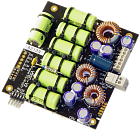 V5SC-SER-UPS
PC/104 Uninterruptable Power Supply (UPS)
The V5SC-SER-UPS is a smart 35 Watt DC to DC UPS with a 5VDC output. A microcontroller provides advanced power management, smart battery charging and an RS-232 communication command and monitoring port. The V5SC-SER-UPS is handles rugged environments, has a wide input range of 6-40V and is ideal for battery or unregulated input applications. The V5SC-SER (without on-board batteries) permit greater backup energy and/or the benefits of a different backup energy chemistry when mated with one of Tri-M’s backup power modules.
Smarts:
log runtime hours / log excessive temperature operation or shock and vibration/ log input voltage conditions and transient occurrences/ log output voltage and loads
setup operating parameters such as maximum and minimum operating temperature
ESN number to uniquely identify each unit
utilizes a multi-stage charging for both the built-in batteries and the external batteries
onboard power management function allows timed on/off control of the V5SC, notification of changes to main power and changes in the battery status
Capable:
a constant off-time current-mode architecture regulator provides excellent line and load transient response for the +5VDC output.
heavy duty transient suppression up to 6,000 volts
ripple reduced to below 20mV
built-in 750mA-Hr 8.4V NiMh battery that is re-charged by the V5SC battery charger; able to provide XX minutes of backup based on X amp draw
state-of-the-art MOSFET based design provides outstanding line and load regulation with efficiencies up to 95 percent
supports external battery packs such as the BAT104-NiMh, or a non-PC/104 pack that is wired to the Battery Connector CN1.
provides up to four stages of battery charging and can charge Lead-Acid, NiCd, and NiMh batteries and is also SMBus level 3 compatible. Charge currents are up to 1.5A, and battery charging voltages from 9.5 to 19.5V.
Applications:
specifically designed for vehicular applications and has heavy-duty transient suppressors (6000W) that clamp the input voltage to safe levels, while maintaining normal power supply operation.
low noise design makes the V5SC ideal for use aboard aircraft or military applications or wherever EMI or RFI must be minimized.
can be programmed to power off the outputs in 60 seconds, and then turn on again 12 hours later
can be configured to meet almost any power supply and battery charging need for embedded applications, whether that be a simple +5V application, or providing power for back lighted LCD panels, or a full NiMh UPS (un-interruptible power supply configuration).
all generated voltages are provided to screw terminals. The RS232 serial port is provided on a 2×5 row pin header.
Advantages
High efficiency
Extended temperature operation
Rugged design
Transient supression
Power/OS
Full UPS with smart charging
PC/104 stackable
V5SC-SER-UPS
PC/104 Uninterruptable Power Supply (UPS)
The V5SC-SER-UPS is a smart 35 Watt DC to DC UPS with a 5VDC output. A microcontroller provides advanced power management, smart battery charging and an RS-232 communication command and monitoring port. The V5SC-SER-UPS is handles rugged environments, has a wide input range of 6-40V and is ideal for battery or unregulated input applications. The V5SC-SER (without on-board batteries) permit greater backup energy and/or the benefits of a different backup energy chemistry when mated with one of Tri-M’s backup power modules.
Smarts:
log runtime hours / log excessive temperature operation or shock and vibration/ log input voltage conditions and transient occurrences/ log output voltage and loads
setup operating parameters such as maximum and minimum operating temperature
ESN number to uniquely identify each unit
utilizes a multi-stage charging for both the built-in batteries and the external batteries
onboard power management function allows timed on/off control of the V5SC, notification of changes to main power and changes in the battery status
Capable:
a constant off-time current-mode architecture regulator provides excellent line and load transient response for the +5VDC output.
heavy duty transient suppression up to 6,000 volts
ripple reduced to below 20mV
built-in 750mA-Hr 8.4V NiMh battery that is re-charged by the V5SC battery charger; able to provide XX minutes of backup based on X amp draw
state-of-the-art MOSFET based design provides outstanding line and load regulation with efficiencies up to 95 percent
supports external battery packs such as the BAT104-NiMh, or a non-PC/104 pack that is wired to the Battery Connector CN1.
provides up to four stages of battery charging and can charge Lead-Acid, NiCd, and NiMh batteries and is also SMBus level 3 compatible. Charge currents are up to 1.5A, and battery charging voltages from 9.5 to 19.5V.
Applications:
specifically designed for vehicular applications and has heavy-duty transient suppressors (6000W) that clamp the input voltage to safe levels, while maintaining normal power supply operation.
low noise design makes the V5SC ideal for use aboard aircraft or military applications or wherever EMI or RFI must be minimized.
can be programmed to power off the outputs in 60 seconds, and then turn on again 12 hours later
can be configured to meet almost any power supply and battery charging need for embedded applications, whether that be a simple +5V application, or providing power for back lighted LCD panels, or a full NiMh UPS (un-interruptible power supply configuration).
all generated voltages are provided to screw terminals. The RS232 serial port is provided on a 2×5 row pin header.
Advantages
High efficiency
Extended temperature operation
Rugged design
Transient supression
Power/OS
Full UPS with smart charging
PC/104 stackable
 Extract104
PC/104 extraction tool / board separator
Frustrated with bent or damaged header pins? The EXTRACT104 is an economical and easy to use tool designed to quickly and professionally separate PC/104 and PC/104+ modules from your stack or test equipment.
Simply position the tool at the edge of the connector and squeeze; the PC/104 pins are smoothly lifted out of the adjacent PC/104 socket.
This rugged, nickel-plated steel device is an indispensable piece of equipment for all test, repair, and production benches.
Extract104
PC/104 extraction tool / board separator
Frustrated with bent or damaged header pins? The EXTRACT104 is an economical and easy to use tool designed to quickly and professionally separate PC/104 and PC/104+ modules from your stack or test equipment.
Simply position the tool at the edge of the connector and squeeze; the PC/104 pins are smoothly lifted out of the adjacent PC/104 socket.
This rugged, nickel-plated steel device is an indispensable piece of equipment for all test, repair, and production benches.
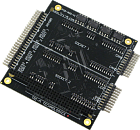 TCB1000
Dual CANbus Serial and COM ports Two MultiTech universal sockets
Tri-M’s TCB1000 series is a new and innovative communication board. This high density design integrates CANbus controllers, serial ports, and wired/wireless functionality into a single board solution. The TCB1000 significantly reduces the size, weight, and cost of embedded solutions while increasing performance and functionality for M2M, Telematics, and data logging applications.
Incorporating dual isolated CANbus controllers, two MultiTech compatible universal sockets, four isolated RS‑232 serial ports, and one isolated RS-485 serial port the TCB1000 is truly a versatile, all-in-one communication solution. Its integrated design offers system builders unprecedented versatility, allowing them to design with only one board while offering their end users any number of communication configurations. Further improving the solution’s flexibility, build options are available for ’lighter’ versions which incorporate only the particular features required for more specialized applications.
All Tri-M products are built for outstanding performance and reliability in harsh environments. The same rugged design features are used in the TCB to make it well suited for operating in harsh environments where, temperature, shock and vibration are factors.
TCB1000
Dual CANbus Serial and COM ports Two MultiTech universal sockets
Tri-M’s TCB1000 series is a new and innovative communication board. This high density design integrates CANbus controllers, serial ports, and wired/wireless functionality into a single board solution. The TCB1000 significantly reduces the size, weight, and cost of embedded solutions while increasing performance and functionality for M2M, Telematics, and data logging applications.
Incorporating dual isolated CANbus controllers, two MultiTech compatible universal sockets, four isolated RS‑232 serial ports, and one isolated RS-485 serial port the TCB1000 is truly a versatile, all-in-one communication solution. Its integrated design offers system builders unprecedented versatility, allowing them to design with only one board while offering their end users any number of communication configurations. Further improving the solution’s flexibility, build options are available for ’lighter’ versions which incorporate only the particular features required for more specialized applications.
All Tri-M products are built for outstanding performance and reliability in harsh environments. The same rugged design features are used in the TCB to make it well suited for operating in harsh environments where, temperature, shock and vibration are factors.
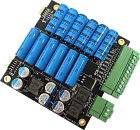 TUP1000
PC/104 Single Board Ultracapacitor UPS
The TUP1000 is a Small Form Factor DC-DC converter using ultra capacitors versus batteries to provide seamless UPS backup capabilities. This high performance power supply can produce 35 watts @ +5VDC or 42 Watts @ +12VDC.
The PC/104 footprint design supports many low power embedded systems requiring short-term power during a power loss.
The TUP1000 has a fully programmable power output of +4.5VDC to +12.6VDC — its rugged design includes transient suppression and locking terminal mating plugs.
Advantages
High efficiency
Extended temperature operation
Rugged design
Transient supression
Power/OS
Full UPS with smart charging
Long life ultracapacitors
PC/104 form factor
TUP1000
PC/104 Single Board Ultracapacitor UPS
The TUP1000 is a Small Form Factor DC-DC converter using ultra capacitors versus batteries to provide seamless UPS backup capabilities. This high performance power supply can produce 35 watts @ +5VDC or 42 Watts @ +12VDC.
The PC/104 footprint design supports many low power embedded systems requiring short-term power during a power loss.
The TUP1000 has a fully programmable power output of +4.5VDC to +12.6VDC — its rugged design includes transient suppression and locking terminal mating plugs.
Advantages
High efficiency
Extended temperature operation
Rugged design
Transient supression
Power/OS
Full UPS with smart charging
Long life ultracapacitors
PC/104 form factor
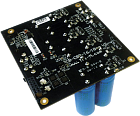 TBP4xxx
Ultracapacitor Backup Modules
TBP4xxx modules are extended temperature, maintenance free, high cycling backup energy modules that when combined with a Tri-M HESC or HPSC smart charging power solution creates a complete uninterruptable power system (UPS) in a PC/104 footprint. The TBP4xxx designed for hostile environments of extreme temperatures and vibration. This rugged backup energy module is ideal for applications that have either a large number of discharge cycles or where a «maintenance free» solution is required such as remote and hard to access locations.
TBP4xxx Modules are available in 500, 1000, 2000 and 4000 joules and mate directly to the bottom of HESC or HPSC power supplies.
Key Specifications
Fully charged in less than a minute
500,000 charge cycles
Deep discharge immune
Extreme temperature operation
High altitude capable (info available on request)
Designed for high vibration and shock environments
PC/104 size footprint
Cable free mating with HESC & HPSC
Advantages
Designed to MIL Standards
Prevents loss of data or corruption due to reliable system backup power
Reduced downtime due to maintenance-free operation
High Density PC/104 footprint
Improved reliability due to cable free integration of HESC & HPSC
Applications
Military & Civil Vehicles
Aerospace & Defence
Industrial Automation
Telecommunications
Undersea & Marine
TBP4xxx
Ultracapacitor Backup Modules
TBP4xxx modules are extended temperature, maintenance free, high cycling backup energy modules that when combined with a Tri-M HESC or HPSC smart charging power solution creates a complete uninterruptable power system (UPS) in a PC/104 footprint. The TBP4xxx designed for hostile environments of extreme temperatures and vibration. This rugged backup energy module is ideal for applications that have either a large number of discharge cycles or where a «maintenance free» solution is required such as remote and hard to access locations.
TBP4xxx Modules are available in 500, 1000, 2000 and 4000 joules and mate directly to the bottom of HESC or HPSC power supplies.
Key Specifications
Fully charged in less than a minute
500,000 charge cycles
Deep discharge immune
Extreme temperature operation
High altitude capable (info available on request)
Designed for high vibration and shock environments
PC/104 size footprint
Cable free mating with HESC & HPSC
Advantages
Designed to MIL Standards
Prevents loss of data or corruption due to reliable system backup power
Reduced downtime due to maintenance-free operation
High Density PC/104 footprint
Improved reliability due to cable free integration of HESC & HPSC
Applications
Military & Civil Vehicles
Aerospace & Defence
Industrial Automation
Telecommunications
Undersea & Marine
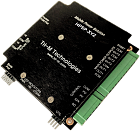 HPSP-XYZ
Triple Programmable Output 240W SFF Power Supply
The HPSP is the product family name of the power supply platform HPSP-x-y-z. The «x» suffix defines the OUT1 voltage, «y» suffix the OUT2 voltage and «z» the OUT3 voltage. In addition to the three main outputs the HPSP also provides a 5VSBY 1A output.
The HPSP is a high power, high performance DC-to-DC converter that supplies three outputs programmable that are programmable up to 24V output and supports an ultra wide input range of 6-50V. The HPSP has two power inputs protected with heavy-duty transient surge stoppers that clamps the input voltage to safe levels. The HPSP is ideal for battery and unregulated input applications. The HPSP uses a flash based microcontroller to supply advanced power management that monitors and controls the operation of the HPSP through a RS232 serial port.
The HPSP is a state-of-the-art Mosfet based design that provides outstanding line and load regulation and high efficiency. The low noise design makes the HPSP ideal for use aboard aircraft or military applications or wherever EMI or RFI must be minimized.
The HPSP advanced power management functions provide timed on/off control of the HPSP, notification of changes to main power and secondary power status.
The HPSP is PC/104 footprint in size of 3.55×3.775 inches with the same mounting holes pattern. However, the HPSP does not include the PC/104 bus connectors. All generated voltages are provided to a removable header. A removable plug allows the HPSP to be easily installed. The RS232 serial port is provided on a 2×5 row pin header.
ATX Compatibility
The HPSP can be configured to be signal compatible to an ATX power supply (The HPSP does not provide −5V, −12V that
standard ATX supplies include but the three outputs can be programmed to provide the standard 3.3V, 5V and 12V).
Advantages
DC to DC converter for embedded applications.
«Load Dump» transient suppression on both main and secondary power supply inputs.
Operates from super wide 6VDC to 50VDC input.
PC/104 size and mounting holes.
Three main programmable outputs OUT1, OUT2 & OUT3. A 1.5A 5VSB outputs is also provided.
Temperature range −40 to 85degC (measured on heat spreader).
Complete with built-in digital temperature sensor.
RS232 serial port for setup, monitoring and control.
Opto-coupled inputs for ignition, and system «shut-down» push-button.
Can be configured to be ATX compatible
HPSP-XYZ
Triple Programmable Output 240W SFF Power Supply
The HPSP is the product family name of the power supply platform HPSP-x-y-z. The «x» suffix defines the OUT1 voltage, «y» suffix the OUT2 voltage and «z» the OUT3 voltage. In addition to the three main outputs the HPSP also provides a 5VSBY 1A output.
The HPSP is a high power, high performance DC-to-DC converter that supplies three outputs programmable that are programmable up to 24V output and supports an ultra wide input range of 6-50V. The HPSP has two power inputs protected with heavy-duty transient surge stoppers that clamps the input voltage to safe levels. The HPSP is ideal for battery and unregulated input applications. The HPSP uses a flash based microcontroller to supply advanced power management that monitors and controls the operation of the HPSP through a RS232 serial port.
The HPSP is a state-of-the-art Mosfet based design that provides outstanding line and load regulation and high efficiency. The low noise design makes the HPSP ideal for use aboard aircraft or military applications or wherever EMI or RFI must be minimized.
The HPSP advanced power management functions provide timed on/off control of the HPSP, notification of changes to main power and secondary power status.
The HPSP is PC/104 footprint in size of 3.55×3.775 inches with the same mounting holes pattern. However, the HPSP does not include the PC/104 bus connectors. All generated voltages are provided to a removable header. A removable plug allows the HPSP to be easily installed. The RS232 serial port is provided on a 2×5 row pin header.
ATX Compatibility
The HPSP can be configured to be signal compatible to an ATX power supply (The HPSP does not provide −5V, −12V that
standard ATX supplies include but the three outputs can be programmed to provide the standard 3.3V, 5V and 12V).
Advantages
DC to DC converter for embedded applications.
«Load Dump» transient suppression on both main and secondary power supply inputs.
Operates from super wide 6VDC to 50VDC input.
PC/104 size and mounting holes.
Three main programmable outputs OUT1, OUT2 & OUT3. A 1.5A 5VSB outputs is also provided.
Temperature range −40 to 85degC (measured on heat spreader).
Complete with built-in digital temperature sensor.
RS232 serial port for setup, monitoring and control.
Opto-coupled inputs for ignition, and system «shut-down» push-button.
Can be configured to be ATX compatible
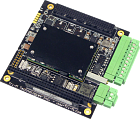 TPSi1085
85W Isolated Embedded Power Supply
Tri-M's TPSi1085 is an isolated PC/104-Plus embedded power supply offering 2250V input/output isolation, 6000W transient protection, active input voltage clamping, wide input ranges of +9V to +33V DC, and maximum efficiency 88%. This rugged design operates in an extended temperature range from -40°C to +85°C (-40°F to +185°F), and features quick-disconnect terminal socket plugs for simple installation.
Galvanically isolated and short circuit protected, the TPSi1085 offers two standard outputs of +3.3V @ 8A and +5V @17A with total combined power of 85W. This isolated power solution also provides remote shutdown functionality, power failure signaling and three dual colour LED status indicators. For PC/104-Plus connectivity, there are also 8bit, 16bit, and PCI headers with passthrough/non-passthrough bus versions available.
For applications requiring a clean isolated power, the TPSi1085 is the perfect solution. This high density, small form factor, and unprecedented SWaP (size, weight, and performance) board is the perfect design for military, aerospace, transportation, and industrial applications.
Advantages
High efficiency
Extended temperature operation
Rugged design
High voltage isolation
Transient supression
Clean and filtered power for the PC/104 bus
Power/OS
TPSi1085
85W Isolated Embedded Power Supply
Tri-M's TPSi1085 is an isolated PC/104-Plus embedded power supply offering 2250V input/output isolation, 6000W transient protection, active input voltage clamping, wide input ranges of +9V to +33V DC, and maximum efficiency 88%. This rugged design operates in an extended temperature range from -40°C to +85°C (-40°F to +185°F), and features quick-disconnect terminal socket plugs for simple installation.
Galvanically isolated and short circuit protected, the TPSi1085 offers two standard outputs of +3.3V @ 8A and +5V @17A with total combined power of 85W. This isolated power solution also provides remote shutdown functionality, power failure signaling and three dual colour LED status indicators. For PC/104-Plus connectivity, there are also 8bit, 16bit, and PCI headers with passthrough/non-passthrough bus versions available.
For applications requiring a clean isolated power, the TPSi1085 is the perfect solution. This high density, small form factor, and unprecedented SWaP (size, weight, and performance) board is the perfect design for military, aerospace, transportation, and industrial applications.
Advantages
High efficiency
Extended temperature operation
Rugged design
High voltage isolation
Transient supression
Clean and filtered power for the PC/104 bus
Power/OS
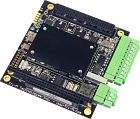 TPSi2100
100W Isolated Power Supply
Tri-M's TPSi2100 is an isolated PC/104-Plus power solution, designed for embedded applications requiring isolation and clean power in rugged environments.
With wide-range input voltages, transient suppression, galvanic isolation, and pluggable terminal mating plugs, this rugged design is ideal for any industrial application.
For applications requiring a clean isolated power, the TPSi2100 is the perfect solution. This high density, small form factor, and unprecedented SWaP (size, weight, and performance) board is the perfect design for military, aerospace, transportation, and industrial applications.
Advantages
High efficiency
Extended temperature operation
Rugged design
High voltage isolation
2250V input/output isolation
6000W transient suppression
Active input voltage clamping
Reverse polarity protection
Clean and filtered power for the PC/104 bus
Power/OS
TPSi2100
100W Isolated Power Supply
Tri-M's TPSi2100 is an isolated PC/104-Plus power solution, designed for embedded applications requiring isolation and clean power in rugged environments.
With wide-range input voltages, transient suppression, galvanic isolation, and pluggable terminal mating plugs, this rugged design is ideal for any industrial application.
For applications requiring a clean isolated power, the TPSi2100 is the perfect solution. This high density, small form factor, and unprecedented SWaP (size, weight, and performance) board is the perfect design for military, aerospace, transportation, and industrial applications.
Advantages
High efficiency
Extended temperature operation
Rugged design
High voltage isolation
2250V input/output isolation
6000W transient suppression
Active input voltage clamping
Reverse polarity protection
Clean and filtered power for the PC/104 bus
Power/OS
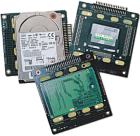 DA104
Hard Drive and Compact Flash adapters for PC/104 stacks
The DA104 provides a convenient means of integrating a 2.5″ IDE hard drive, M‑Systems CompactFlash, or M‑Systems IDE2000 Flash Disk onto a PC/104 «stack». Connection of the drive to the host CPU IDE port is supported by a standard 40 pins ribbon cable.
The 5VDC power for the drives is supplied either though the PC/104 bus, or 2 positions screw terminal. For additional memory, a second 2.5″ hard drive or IDE2000 Flash Disk can be mounted to the underside of the module.
DA104
Hard Drive and Compact Flash adapters for PC/104 stacks
The DA104 provides a convenient means of integrating a 2.5″ IDE hard drive, M‑Systems CompactFlash, or M‑Systems IDE2000 Flash Disk onto a PC/104 «stack». Connection of the drive to the host CPU IDE port is supported by a standard 40 pins ribbon cable.
The 5VDC power for the drives is supplied either though the PC/104 bus, or 2 positions screw terminal. For additional memory, a second 2.5″ hard drive or IDE2000 Flash Disk can be mounted to the underside of the module.
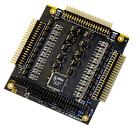 IO104-60IN
PC/104 Digital IO Module
The IO104-60IN board is a a simple PC/104 opto isolated input card featuring 60 inputs.
The inputs are accessed through I/O memory reads. The 60 inputs are grouped as seven sets of eight inputs, and one set of four inputs.
Each group of inputs is accessed through an I/O memory address, which is an offset from the base decode address.
IO104-60IN
PC/104 Digital IO Module
The IO104-60IN board is a a simple PC/104 opto isolated input card featuring 60 inputs.
The inputs are accessed through I/O memory reads. The 60 inputs are grouped as seven sets of eight inputs, and one set of four inputs.
Each group of inputs is accessed through an I/O memory address, which is an offset from the base decode address.
